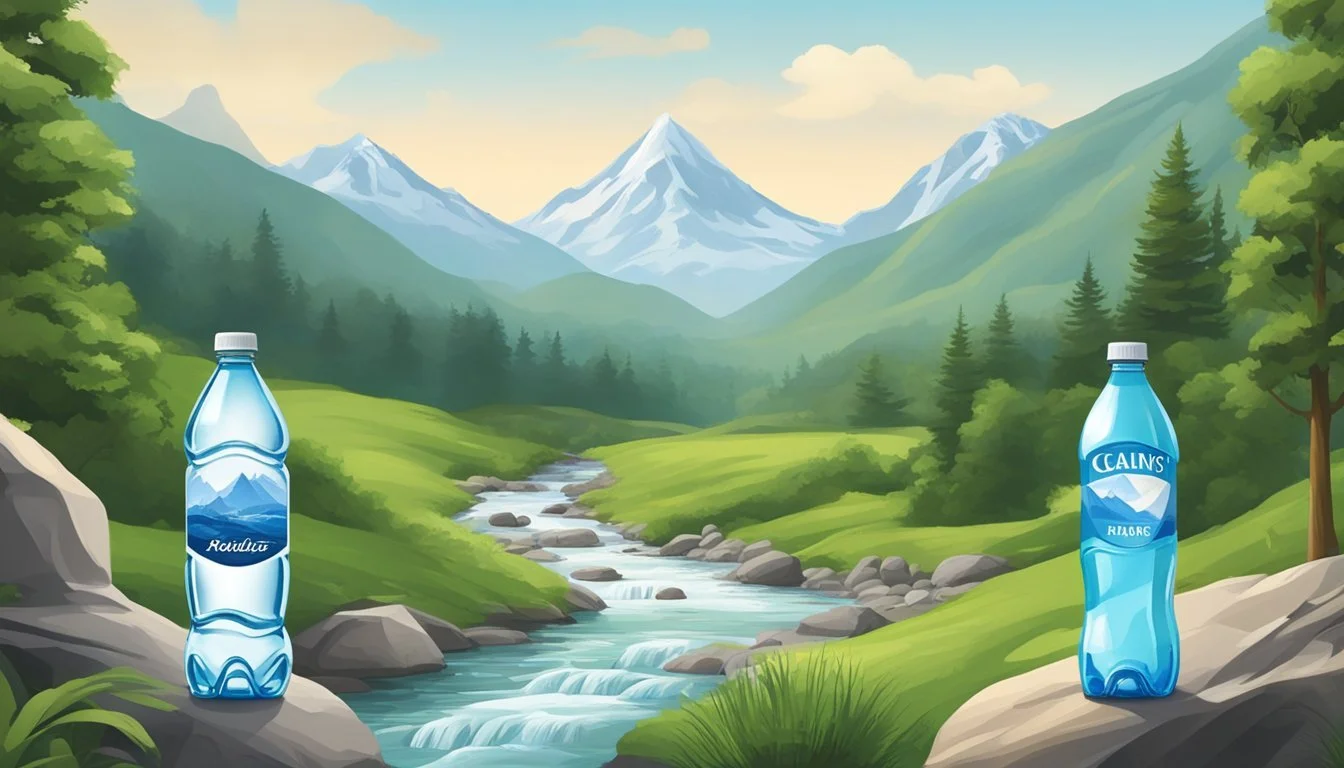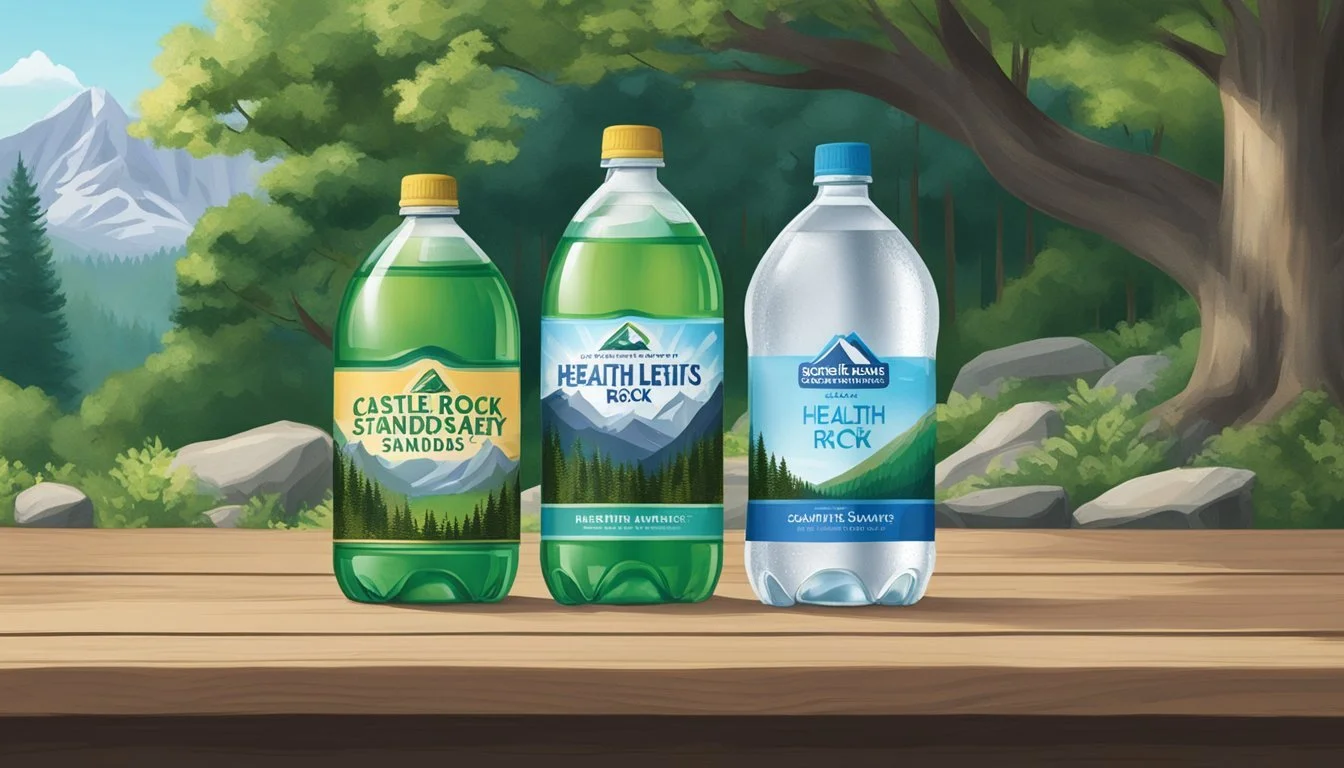Ethos vs. Castle Rock
Comparing Quality and Taste
Ethos and Castle Rock are two prominent brands in the bottled water market, each with its unique attributes. Ethos emphasizes its commitment to sustainability and its charitable contributions to clean water initiatives, making it an appealing choice for environmentally conscious consumers. Castle Rock differentiates itself with its source from natural springs in the Castle Rock region, offering a taste that many find pure and refreshing.
Ethos is known for its recyclable packaging and dedication to social causes, adding value beyond just hydration. Meanwhile, Castle Rock prides itself on its pristine source and minimal processing, aiming to deliver water as nature intended.
When choosing between Ethos and Castle Rock, consider what aspects are most important. If sustainability and social impact are priorities, Ethos is the clear winner. For those who value natural spring sources and minimal intervention, Castle Rock stands out. Both offer quality options, making them strong contenders in the bottled water market.
The Importance of Hydration
Maintaining proper hydration is crucial for overall health, influencing everything from physical performance to cognitive function. This section explores the health benefits of staying hydrated and the various sources of hydration available.
Health and Hydration
Proper hydration supports nearly every major bodily function. Water is vital for cellular function, aiding in nutrient transportation and waste removal.
Individuals who stay well-hydrated typically experience better skin health, improved digestion, and more stable energy levels. Hydration also plays a crucial role in regulating body temperature.
Dehydration can lead to symptoms like headaches, fatigue, and dizziness. In extreme cases, it can cause serious health problems such as kidney stones or urinary tract infections.
Athletes and active individuals should pay special attention to their hydration levels. Water and mineral water are commonly recommended because they can replenish and sustain the balance of electrolytes lost through sweat.
Hydration Sources
Various sources can contribute to daily hydration needs. Tap water is generally the most accessible and cost-effective source. It undergoes purification processes to remove contaminants and is regulary monitored for safety.
Purified water refers to water that has had impurities removed through methods like reverse osmosis or distillation. This type of water is excellent for those looking for a cleaner, albeit sometimes less flavorful, hydration option.
Mineral water, sourced from natural springs, contains various minerals like magnesium and calcium, which can be beneficial for overall health. It often offers a cleaner, more refreshing taste compared to other types of water.
Spring water, similar to mineral water, is another excellent source as it comes directly from natural springs. It undergoes minimal processing, retaining many natural minerals, making it a popular choice for hydration.
Understanding Bottled Water
Bottled water varies widely in terms of type, source, and purification methods. This guide will explore these differences to help you make a more informed choice.
Types of Bottled Water
Bottled water is categorized based on its source and treatment. Common types include:
Spring Water: Sourced directly from a natural spring, this water is typically rich in minerals.
Purified Water: Subjected to processes like reverse osmosis or distillation, this water is free of impurities.
Mineral Water: Contains minerals naturally present at the source.
Well Water: Drawn from a natural aquifer, often contains various minerals.
Sparkling Water: Naturally carbonated or artificially infused with carbon dioxide.
Each type offers unique benefits and characteristics.
Water Sourcing
The source of bottled water greatly influences its taste and mineral content. Natural spring and aquifer sources often yield water with higher mineral content, contributing to a distinctive mineral aftertaste.
Ethos Water sources its water from carefully selected springs, focusing on sustainability and purity. Castle Rock also prides itself on using springs located in pristine environments.
Purified water typically comes from municipal sources but undergoes extensive treatment to ensure it is free of contaminants.
Purification Processes
The purification process varies by brand and type. Reverse osmosis and distillation are common methods for producing purified water, removing impurities and contaminants.
Ethos Water employs standard purification processes to ensure safety and quality.
Spring and well waters like Castle Rock's undergo less rigorous purification, preserving natural minerals.
Fluoride and chlorination may be added to some bottled waters for safety and dental health benefits.
Understanding these processes helps in choosing bottled water that aligns with health and taste preferences.
Ethos Water Analysis
Ethos Water, acquired by Starbucks, focuses on providing high-quality bottled water while also contributing to global clean water initiatives. This section covers the source of Ethos Water and its purification process to evaluate its quality.
Ethos Water Source
Ethos Water is sourced from natural springs in the United States. These springs are carefully selected to ensure a consistent supply of fresh and clean water. The water is naturally filtered through geological formations, which helps in maintaining its purity and mineral content. Ethos collaborates closely with local authorities to ensure their water sources comply with environmental standards, including those set by the EPA.
Starbucks' acquisition of Ethos has given it additional resources to maintain and monitor its water sources. This ensures both sustainability and purity in the long term. By prioritizing quality sources, Ethos provides consumers with bottled water that is both refreshing and responsibly sourced.
Ethos Purification and Quality
Ethos employs a comprehensive purification process that includes reverse osmosis and ozonation. Reverse osmosis removes contaminants and impurities, ensuring that what remains is pure water. The water is further treated with ozone to enhance its safety and to prolong its shelf life without adding any preservatives or chemicals.
Testing for quality is frequent and rigorous to meet both EPA and FDA standards. Ethos also ensures the water retains essential minerals for taste and health benefits. The quality control measures implemented by Ethos reflect Starbucks' commitment to providing premium products while maintaining high safety standards. Consumers can rely on Ethos for a consistently clean, fresh, and safe bottled water experience.
Castle Rock Water Analysis
Castle Rock Water, sourced from the Shasta Spring, offers consumers a naturally purified alkaline water. This section delves into where Castle Rock sources its water and the purification processes involved to ensure its high quality.
Castle Rock Source
Castle Rock Water originates from the Shasta Spring, fed by glacial runoff and filtered through layers of volcanic rock. This natural process not only purifies the water but also enriches it with essential minerals. Located at the base of Mount Shasta, this spring is known for its pristine quality.
The geographical location and geological features contribute to the water's unique taste and high quality. It is bottled directly at the source to maintain its purity. Such natural filtration results in water that is both refreshing and healthy, providing consumers with a premium option.
Castle Rock Purification and Quality
Castle Rock Water undergoes a natural purification cycle that spans from ocean to rain and glacier to spring. This unique process involves filtration through volcanic rock, which eliminates contaminants and enhances mineral content. The water's journey to the bottle ensures an alkalinity that many consumers find beneficial to health.
The company uses eco-friendly glass bottles, reflecting a commitment to sustainability. Each bottle of Castle Rock Water costs $2.99 and provides a serving size of 8fl oz (240ml), with approximately 4.2 servings per container. The emphasis on quality and environmental responsibility sets Castle Rock Water apart in the competitive bottled water market.
Taste Profile Comparison
Ethos and Castle Rock offer distinct taste experiences. Flavor, mouthfeel, mineral aftertaste, and pH levels play significant roles in this comparison.
Flavor and Mouthfeel
Ethos Water: Known for its clean, crisp taste with very minimal aftertaste. The purity of Ethos water is often highlighted by its smooth mouthfeel and neutral taste, appealing to those who prefer a less complex flavor profile.
Castle Rock Water: Offers a more layered flavor experience. It has a slight natural sweetness and a subtle mineral aftertaste, lending a fuller mouthfeel. This water is often praised for its balance between refreshing and mildly rich flavors, making it more distinctive.
Taste Influencing Factors
Mineral Content: Ethos maintains a low mineral content, contributing to its clean taste. In contrast, Castle Rock’s higher mineral content, especially calcium and magnesium, influences its subtle sweetness and minerally aftertaste.
pH Levels: Ethos typically has a neutral pH level around 7, supporting its balanced taste without noticeable acidity or alkalinity. Castle Rock, with a natural alkaline pH of about 8.0, can have a smoother taste, appealing to those who seek alkaline water for its purported health benefits.
Source: Ethos sources its water from protected springs, ensuring high quality. Castle Rock’s water is sourced from pristine springs in Shasta-Trinity National Forest, which adds to its unique taste profile influenced by the natural filtration through volcanic rock.
Health and Safety Standards
When comparing Ethos and Castle Rock bottled water, examining the health and safety standards is crucial. Specifically, we look at their water quality certifications and the level of contaminants and purity in each brand.
Water Quality Certifications
Ethos and Castle Rock both adhere to rigorous health and safety standards to ensure clean drinking water. Castle Rock prides itself on being certified by the EPA for its natural spring water. Additionally, Castle Rock holds an NSF certification for its sustainable practices and quality controls.
Ethos, meanwhile, emphasizes its commitment to clean water initiatives, often collaborating with charitable organizations. Their purification processes meet the FDA’s purified water standards, and they employ advanced filtration techniques. The careful oversight and certifications help assure consumers of each brand’s dedication to health.
Contaminants and Purity
Ensuring water purity is a significant focus for both brands. Studies highlight that bottled water can contain nanoplastic particles. Ethos conducts stringent testing to minimize contaminants, meeting standards for purified water set by regulatory bodies. They also frequently publish their water quality reports, ensuring transparency.
Castle Rock, sourced from natural springs, emphasizes the purity and mineral content of its water. It undergoes fewer industrial processes, maintaining a natural composition. Both brands strive to limit contaminants and ensure the purity of their water, making them suitable choices for health-conscious consumers.
Sustainability and Environmental Impact
Ethos and Castle Rock take different approaches to sustainability and environmental impact, with each brand emphasizing its efforts in eco-friendly packaging and water source sustainability.
Eco-Friendly Packaging
Ethos utilizes recyclable plastic bottles, which contribute to reducing plastic waste. Their commitment also includes BPA-free materials to ensure consumer safety. Additionally, Ethos supports charitable initiatives, promoting clean water access globally.
Castle Rock opts for glass bottles, significantly reducing the environmental footprint compared to plastic. The use of glass ensures reusability and recyclability. This approach aligns with environmentally conscious practices by minimizing plastic waste and promoting better sustainability standards.
Water Source Sustainability
Ethos sources its water from natural springs, focusing on maintaining water quality and environmental balance. The brand implements rigorous measures to ensure sustainable water extraction, preventing depletion and preserving the ecosystem.
Castle Rock shares a similar commitment, sourcing from sustainable locations. They emphasize renewable and natural water sources, ensuring minimal impact on local water tables and surrounding environments. Their stringent protocols aim to safeguard water availability for future generations.
Consumer Convenience
Ethos and Castle Rock bottled waters offer varying degrees of consumer convenience. The key aspects to consider include their availability, accessibility, and the practicalities related to their packaging and portability.
Availability and Accessibility
Ethos water is widely available in numerous retail outlets, including major grocery chains and convenient stores across the United States. It has a strong presence in Starbucks locations, promoting wide reach and easy access.
Castle Rock water, on the other hand, might be found in selected high-end grocery stores and specialty shops. While it offers a niche market appeal, this can limit its accessibility compared to Ethos.
Ethos also has an online presence, allowing for easy ordering and home delivery, which Castle Rock matches but lacks the extensive distribution network of its counterpart. Both offer availability on popular online platforms such as Amazon, making them accessible to a broader audience.
Packaging and Portability
Ethos emphasizes sustainable packaging with recyclable plastic bottles and some boxed water options, highlighting eco-friendly practices. The lightweight plastic bottles are designed for easy transport and on-the-go consumption.
Castle Rock often distinguishes itself with more premium packaging, including glass bottles that appeal to environmentally conscious consumers. Though aesthetically pleasing and eco-friendly, glass bottles can be less convenient for portability due to their fragility and heavier weight.
Both brands aim for portability but cater to different user preferences. Ethos focuses on practicality for active lifestyles, whereas Castle Rock prioritizes a premium feel that appeals to specific consumer segments.
Comparative Analysis
Ethos and Castle Rock both stand out in the bottled water industry for distinct reasons. Their market presence, reputation, pricing, and value proposition have significant impacts.
Market Presence and Reputation
Ethos Water has cultivated a strong market presence through its partnership with Starbucks. This association has helped Ethos build a reputation emphasizing corporate social responsibility, particularly through its contributions to global water initiatives.
Castle Rock is recognized for sourcing water from pristine, natural springs in Mount Shasta, California. This lends the brand a reputation for purity and commitment to high-quality standards. Castle Rock is often compared with notable brands like Fiji and Voss for its emphasis on natural sourcing and eco-friendly practices.
Price Point and Value
Ethos Water typically falls into the mid-tier pricing bracket among premium bottled water brands. Consumers are not only paying for the water but also the added value of contributing to clean water projects globally. This philanthropic angle can justify the price point for socially-conscious buyers.
Castle Rock's pricing is competitive with other premium brands such as Essentia and Smartwater. Consumers who prioritize the natural spring source and sustainable practices may find the slightly higher price acceptable. Castle Rock’s value proposition centers around its high-quality, naturally sourced water, aligning with consumer preferences for purity and environmental responsibility.
More About Ethos
Ethos vs Mountain Valley Spring Water: Which Bottled Water is Better?
Ethos vs Richard's Rainwater: Which Bottled Water is Better?
Ethos vs Whole Foods Italian Still Mineral water: Which Bottled Water is Better?
More About Castle Rock
Aqua Carpatica vs Castle Rock: Which Bottled Water is Better?
Castle Rock vs Cascade Mountain: Which Bottled Water is Better?
Castle Rock vs Crystal Geyser: Which Bottled Water is Better?
Castle Rock vs Hawaii Volcanic: Which Bottled Water is Better?
Castle Rock vs Hawaiian Springs: Which Bottled Water is Better?
Castle Rock vs Kirkland Signature: Which Bottled Water is Better?
Castle Rock vs Purely Sedona: Which Bottled Water is Better?
Castle Rock vs Richard's Rainwater: Which Bottled Water is Better?
Castle Rock vs Solan de Cabras: Which Bottled Water is Better?
Castle Rock vs Talking Rain AQA: Which Bottled Water is Better?
Castle Rock vs Whole Foods 365: Which Bottled Water is Better?
Castle Rock vs Whole Foods Italian Still Mineral water: Which Bottled Water is Better?
Core Hydration vs Castle Rock: Which Bottled Water is Better?
Icelandic Glacial vs Castle Rock: Which Bottled Water is Better?
Mountain Valley Spring Water vs Castle Rock: Which Bottled Water is Better?
Nestle Pure Life vs Castle Rock: Which Bottled Water is Better?
Poland Spring vs Castle Rock: Which Bottled Water is Better?
San Pellegrino vs Castle Rock: Which Bottled Water is Better?





